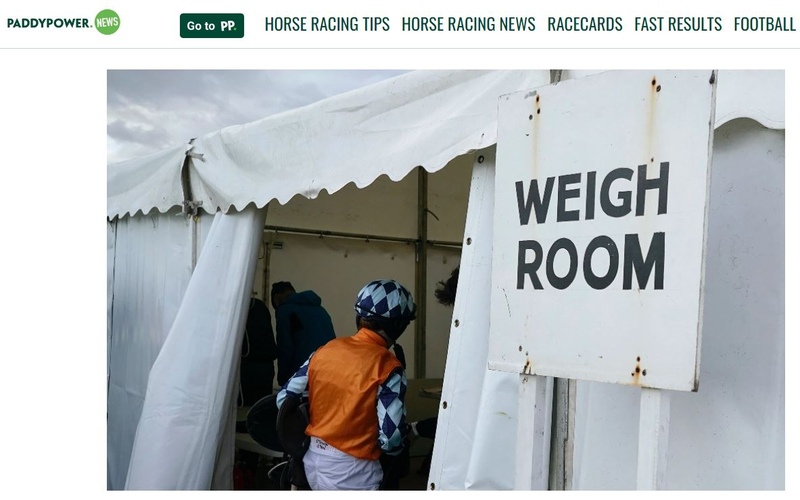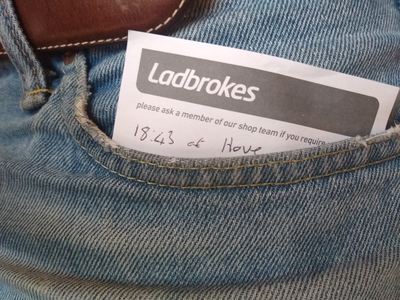Anyone who has ever attended a day at the races, or even taken in a meeting on TV, will likely have heard the announcement of “weighed in, weighed in” over the public address system, or the commentator informing viewers that, “all runners have weighed in, result confirmed”. These are statements which are easy to pay little attention to, but which nevertheless represent a crucial aspect of the horse racing process.
Whilst for punters the time to celebrate is the moment their inspired selection crosses the line in front, it is only after all runners have “weighed in” that the official result is confirmed, and bets will be paid out. All of which makes “weighing in” an essential part of the racing rulebook for owners, trainers, jockeys, and bettors alike. But what exactly does it all mean?
Let’s take a closer look.
Weights and the Handicapping System
 Whatever the type of race, be it on the flat or over jumps, all runners will be allocated a specific weight that they must carry during the race.
Whatever the type of race, be it on the flat or over jumps, all runners will be allocated a specific weight that they must carry during the race.
In a handicap contest, this weight will be determined by the official handicapper who has the task of assigning an ability rating – known as the horse’s Official Rating (OR) – to every runner in training. This rating will then be used to assign the weights carried in a handicap race – the higher the rating, the greater the amount of weight to be carried, with each rating point equating to exactly one pound (1lb) in weight.
Take an example of a handicap contest featuring three runners rated 100, 96 and 90 respectively. As the highest-rated horse, the 100-rated runner may be required to carry the top weight of 10 stone (10st which is the same same 140lb). The 96-rated runner would then carry four pounds less, equating to 9st10lb, with the 90-rated horse carrying six pounds less again, equating to 9st4lb. The purpose of this handicapping system is to slow down the quicker horses in relation to the competition, granting all runners a theoretically equal chance of winning, and creating an exciting betting medium.
Of course, not all races are handicap events, there are also those contests which aim to determine the best of the best. Generally falling into the Group/Graded or Listed categories, these races include the likes of the Epsom Derby, the Cheltenham Gold Cup, and many other high-profile events throughout the season. Referred to as “Level Weights” races, there may still be certain discrepancies between the weights carried by the various runners. However, these differences will not be determined by the horse’s handicap rating, but rather by age and sex allowances, or penalties for winning previous races. For example, colts and geldings will carry more weight than fillies and mares because they are naturally physically stronger.
Whatever the criteria used in determining the weights, the sport must have an effective way of determining that the correct weights are carried throughout the race. The manner in which this aspect of racing is monitored is via the weighing out and weighing in system.
Weighing Out

Before every horse race held around the world, jockeys must first “weigh out”. This process involves the rider reporting to the Clerk of the Scales, who will then ask the rider to stand on a set of scales whilst carrying all of the equipment to be carried by the horse during the race, including saddle, bridle and so on.
Any discrepancy between the weight recorded on the scales, and the amount allocated by the handicapper, will be made up by thin lead plates which are inserted into the saddle cloth of the horse.
If the jockey weighs out over the allocated amount, the jockey and horse will still be permitted to compete in the race, but the betting public will be informed that the horse will be carrying more than advertised, for example, R McDonald rides 3lbs overweight.
Having completed the weighing out procedure, all equipment, including any required lead plates, will be handed to the trainer or trainer’s assistant who will then go about saddling the horse for the race.
Weighing In
Whilst the weighing out process deals with ensuring that the horse begins the race carrying the correct weight, weighing in determines that the horse also finishes the race with the allocated amount of weight on its back.
Having completed the race, all jockeys must once again make their way to the Clerk of the Scales, who will then repeat the process of weighing the jockey complete with all equipment carried during the race. Provided the weights are correct, the “weighed in, weighed in” announcement will be made, and the official result declared.
What Happens if the Weight is Different?

If a jockey weighs in with an incorrect weight, the clerk of the scales will lodge an objection, and a stewards’ enquiry will follow.
The exact process and ruling will then depend upon whether the jockey in question weighed in with too little or too much weight.
Weighed In Under Weight
Should the jockey weigh in more than a pound below the allocated weight, the horse will be disqualified, and the rider will be penalised – usually in the form of a ban for a specified number of days or a fine.
If it is the rider of the winning horse who weighs in light, the horse which finished second will be awarded the race and paid out as the winner.
In any event, all runners who finish behind a disqualified runner will have their finishing position upgraded by one – potentially affecting the each way positions and pay-outs. Note that the one-pound variance is permitted to account for any weight the rider may lose due to their exertions during the race.
Weighed In Over
Should a rider weigh in two pounds or more over the allocated weight, the result will stand, as the horse has gained no benefit through carrying additional weight. The rider however will still be reported and may again face a ban and/or fine.
Overweight amounts of less than two pounds will not be investigated, as it is accepted that weather conditions may result in a rider weighing in a small amount above the allocated weight. Drenched and mud-spattered jockeys may well weigh in slightly heavier during wet conditions.
Betting Implications
 From a betting perspective, whether or not an incorrect weigh-in affects your wager will depend upon the terms and conditions of your bookmaker.
From a betting perspective, whether or not an incorrect weigh-in affects your wager will depend upon the terms and conditions of your bookmaker.
Happily, the majority of betting companies operate a “First Past The Post” policy, meaning they will pay out on the order in which the runners finish the race AND any subsequently amended result.
Note however that this can vary between firms.
Some may pay out only on the official result after the weigh in, whilst others may also pay out on the amended result in the instance of interference, but not if there is a problem with the weights.
If in doubt, consult the terms and conditions of your bookmaker of choice.
